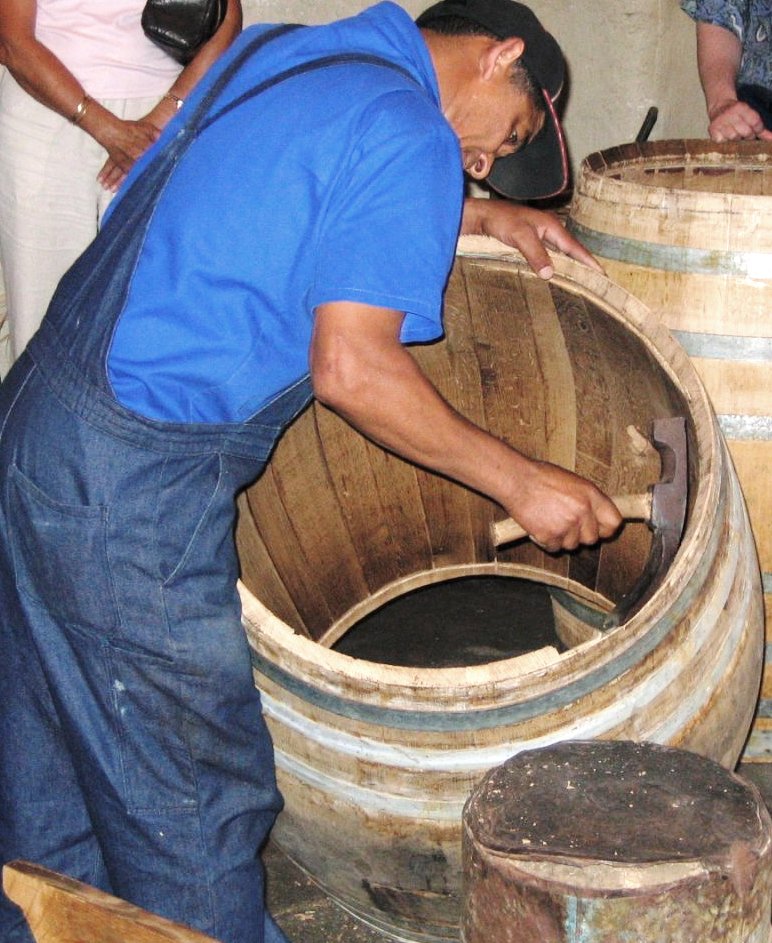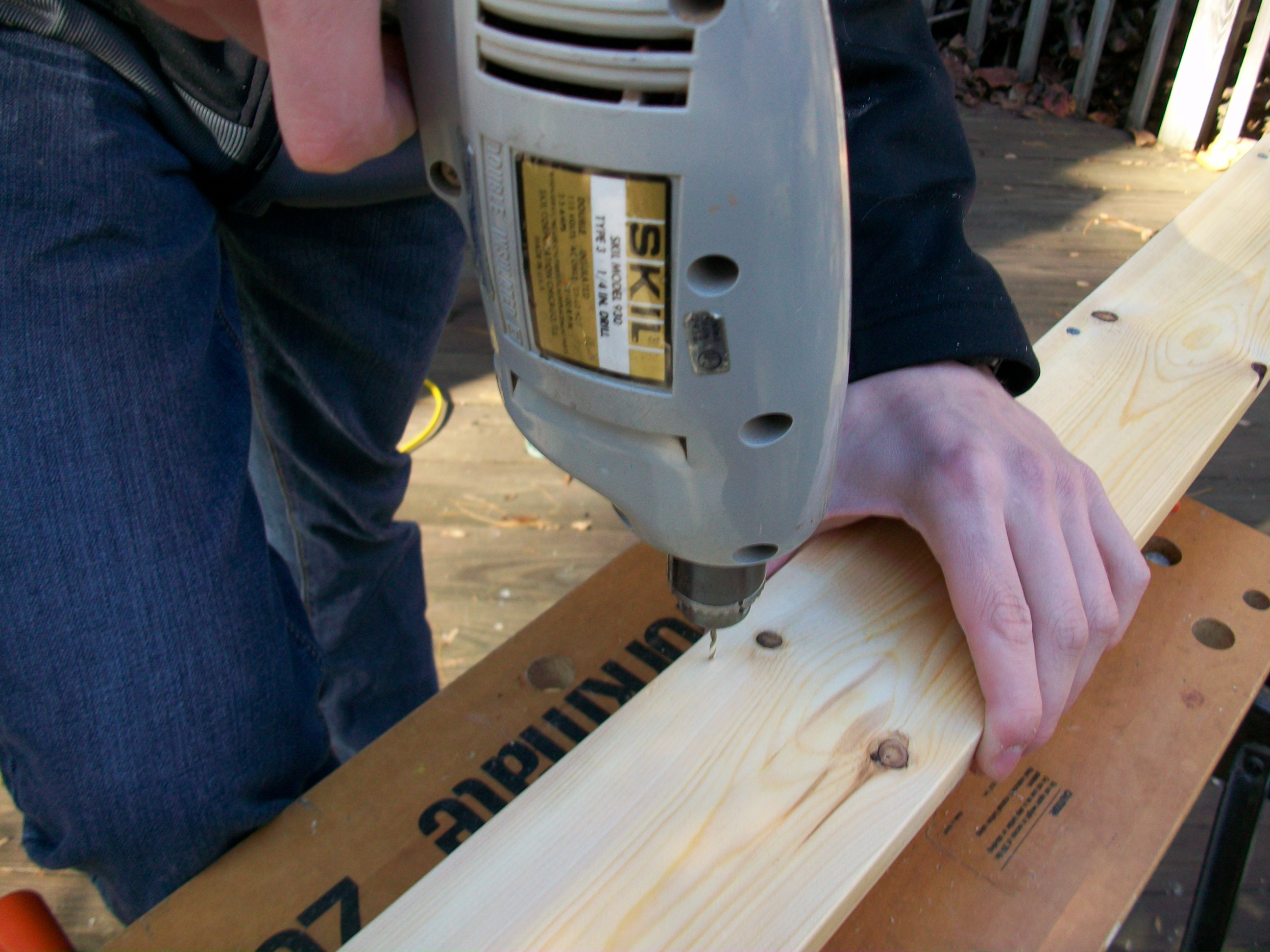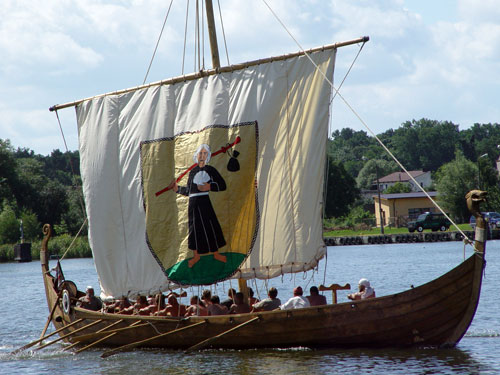|
Riving
Wood splitting (''riving'',"Riving" def. 1.b. ''Oxford English Dictionary'' Second Edition on CD-ROM (v. 4.0) Oxford University Press 2009 cleaving) is an ancient technique used in carpentry to make lumber for making wooden objects, some basket weaving, and to make firewood. Unlike wood sawing, the wood is split along the grain using tools such as a hammer and wedges, splitting maul, cleaving axe A cleaving axe or cleaver is a form of axe used within green woodworking to split wood lengthways. Cleaving (riving) is used to turn a log into lumber or billets (short or thick pieces of wood) into firewood. Splitting axe is sometimes described ..., side knife, or froe. Woodworking In woodworking carpenters use a wooden siding which gets its name, clapboard, from originally being split from logs—the sound of the plank against the log being a clap. This is used in clapboard architecture and for wainscoting. Coopers use oak clapboards to make barrel staves. Split-rail fence ... [...More Info...] [...Related Items...] OR: [Wikipedia] [Google] [Baidu] |
Cleaving Axe
A cleaving axe or cleaver is a form of axe used within green woodworking to split wood lengthways. Cleaving (riving) is used to turn a log into lumber or billets (short or thick pieces of wood) into firewood. Splitting axe is sometimes described as an old name for a splitting maul or froe. Overview A cleaving axe resembles a felling axe but is heavier, more wedge shaped, not sharp-edged and the poll is flat for driving wedges. The edge is of medium length, almost straight with just a slight camber, and symmetrical top and bottom. A section through the edge is that of a simple splitting wedge. Abbott, Green woodwork, p. 42 The edge itself does not need to be sharp: ''cleaving'' relies more on wedge action than ''chopping'' (cutting) with an edge. The section of the axe should be triangular though, with flat sides, rather than the deeply hollow-sided forged and welded axes, or the modern convex-sided "apple pip" axe grind. Nor should the edge be ground at a bevel. The wo ... [...More Info...] [...Related Items...] OR: [Wikipedia] [Google] [Baidu] |
Lumber
Lumber is wood that has been processed into dimensional lumber, including beams and planks or boards, a stage in the process of wood production. Lumber is mainly used for construction framing, as well as finishing (floors, wall panels, window frames). Lumber has many uses beyond home building. Lumber is sometimes referred to as timber as an archaic term and still in England, while in most parts of the world (especially the United States and Canada) the term timber refers specifically to unprocessed wood fiber, such as cut logs or standing trees that have yet to be cut. Lumber may be supplied either rough- sawn, or surfaced on one or more of its faces. Beside pulpwood, ''rough lumber'' is the raw material for furniture-making, and manufacture of other items requiring cutting and shaping. It is available in many species, including hardwoods and softwoods, such as white pine and red pine, because of their low cost. ''Finished lumber'' is supplied in standard sizes, mo ... [...More Info...] [...Related Items...] OR: [Wikipedia] [Google] [Baidu] |
Basket Weaving
Basket weaving (also basketry or basket making) is the process of weaving or sewing pliable materials into three-dimensional artifacts, such as baskets, mats, mesh bags or even furniture. Craftspeople and artists specialized in making baskets may be known as basket makers and basket weavers. Basket weaving is also a rural craft. Basketry is made from a variety of fibrous or pliable materials—anything that will bend and form a shape. Examples include pine, straw, willow, oak, wisteria, forsythia, vines, stems, animal hair, hide, grasses, thread, and fine wooden splints. There are many applications for basketry, from simple mats to hot air balloon gondolas. Many Indigenous peoples are renowned for their basket-weaving techniques. History While basket weaving is one of the widest spread crafts in the history of any human civilization, it is hard to say just how old the craft is, because natural materials like wood, grass, and animal remains decay naturally and consta ... [...More Info...] [...Related Items...] OR: [Wikipedia] [Google] [Baidu] |
Sawmill
A sawmill (saw mill, saw-mill) or lumber mill is a facility where logging, logs are cut into lumber. Modern sawmills use a motorized saw to cut logs lengthwise to make long pieces, and crosswise to length depending on standard or custom sizes (dimensional lumber). The Portable sawmill, "portable" sawmill is of simple operation. The log lies flat on a steel bed, and the motorized saw cuts the log horizontally along the length of the bed, by the operator manually pushing the saw. The most basic kind of sawmill consists of a chainsaw and a customized jig ("Alaskan sawmill"), with similar horizontal operation. Before the invention of the sawmill, boards were made in various manual labour, manual ways, either wood splitting, rived (split) and plane (tool), planed, hewing, hewn, or more often hand sawn by two men with a whipsaw, one above and another in a saw pit below. The earliest known mechanical mill is the Hierapolis sawmill, a Roman water-powered stone mill at Hierapolis, Asia ... [...More Info...] [...Related Items...] OR: [Wikipedia] [Google] [Baidu] |
Merlin Usteye Bokion
Merlin ( cy, Myrddin, kw, Marzhin, br, Merzhin) is a mythical figure prominently featured in the legend of King Arthur and best known as a mage, with several other main roles. His usual depiction, based on an amalgamation of historic and legendary figures, was introduced by the 12th-century British author Geoffrey of Monmouth. It is believed that Geoffrey combined earlier tales of Myrddin and Ambrosius, two legendary Briton prophets with no connection to Arthur, to form the composite figure called Merlinus Ambrosius ( cy, Myrddin Emrys, br, Merzhin Ambroaz). Geoffrey's rendering of the character became immediately popular, especially in Wales. Later writers in France and elsewhere expanded the account to produce a fuller image, creating one of the most important figures in the imagination and literature of the Middle Ages. Merlin's traditional biography casts him as an often-mad being born of a mortal woman, sired by an incubus, from whom he inherits his supernatural powe ... [...More Info...] [...Related Items...] OR: [Wikipedia] [Google] [Baidu] |
Carpentry
Carpentry is a skilled trade and a craft in which the primary work performed is the cutting, shaping and installation of building materials during the construction of buildings, ships, timber bridges, concrete formwork, etc. Carpenters traditionally worked with natural wood and did rougher work such as framing, but today many other materials are also used and sometimes the finer trades of cabinetmaking and furniture building are considered carpentry. In the United States, 98.5% of carpenters are male, and it was the fourth most male-dominated occupation in the country in 1999. In 2006 in the United States, there were about 1.5 million carpentry positions. Carpenters are usually the first tradesmen on a job and the last to leave. Carpenters normally framed post-and-beam buildings until the end of the 19th century; now this old-fashioned carpentry is called timber framing. Carpenters learn this trade by being employed through an apprenticeship training—normally 4 years ... [...More Info...] [...Related Items...] OR: [Wikipedia] [Google] [Baidu] |
Pilot Hole
In construction, a pilot hole is a small hole drilled into a piece of construction material. Its purpose may be: #to guide a larger drill to the appropriate location and ease the job of the larger drill #allow for the insertion of another hole-making tool, such as a knockout punch, that will produce the final-sized hole, or #locate, guide, and provide clearance for a self-threading screw in wood or plastic to prevent damaging the material or breaking the screw. Pilot for large holes A pilot hole may be drilled the full extent of the final hole, or may only be a portion of the final depth. The pilot drill may be a standard twist drill, another type of drill bit appropriate for the material, or, when the primary purpose is precisely locating a hole, may be made with a short, stiff center drill. The pilot hole also reduces the power needed to turn a large drill bit, and reduces the large bit breakage risk. For twist drill bits, the pilot size is usually selected so that the chi ... [...More Info...] [...Related Items...] OR: [Wikipedia] [Google] [Baidu] |
Splitting Maul
A splitting maul also known as a ''block buster'', ''block splitter'', ''chop and maul'', ''sledge axe'', ''go-devil'' or ''hamaxe'' is a heavy, long-handled axe used for splitting a piece of wood along its grain. One side of its head is like a sledgehammer, and the other side is like an axe. Tools ; Wedged mauls: A typical wood splitting maul has a head weight of 6 to 8 lb or approximately 2.7 to 3.6 kg, respectively. Traditionally, mauls have a wedge-shaped head, but some modern versions have conical heads or swiveling sub-wedges. The original maul resembles an axe but with a broader head. For splitting wood, this tool is much better than a typical axe. The weight of it is more advantageous, and it is less likely to become stuck in the wood thanks to its width. The wedge section of a maul head must be slightly convex to avoid jamming and it cannot have the elongated "hollow ground" concave-section that a cutting axe may use. Unlike an axe, maul handles are norma ... [...More Info...] [...Related Items...] OR: [Wikipedia] [Google] [Baidu] |
Shake (shingle)
Wood shingles are thin, tapered pieces of wood primarily used to cover roofs and walls of buildings to protect them from the weather. Historically shingles, also known as shakes, were split from straight grained, knot free ''bolts'' of wood. Today shingles are mostly made by being cut which distinguishes them from shakes, which are made by being split out of a bolt. Wooden shingle roofs were prevalent in the North American colonies (for example in the Cape-Cod-style house), while in central and southern Europe at the same time, thatch, slate and tile were the prevalent roofing materials. In rural Scandinavia, wood shingle roofs were a common roofing material until the 1950s. Wood shingles are susceptible to fire and cost more than other types of shingle so they are not as common today as in the past. Distinctive shingle patterns exist in various regions created by the size, shape, and application method. Special treatments such as swept valleys, combed ridges, decorative butt ... [...More Info...] [...Related Items...] OR: [Wikipedia] [Google] [Baidu] |
Viking Ship
Viking ships were marine vessels of unique structure, used in Scandinavia from the Viking Age throughout the Middle Ages. The boat-types were quite varied, depending on what the ship was intended for, but they were generally characterized as being slender and flexible boats, with symmetrical ends with true keel. They were Clinker (boat building), clinker built, which is the overlapping of planks riveted together. Some might have had a dragon's head or other circular object protruding from the bow and stern for design, although this is only inferred from historical sources. Viking ships were used both for military purposes and for long-distance trade, exploration and colonization. In the literature, Viking ships are usually seen divided into two broad categories: merchant ships and warships, the latter resembling narrow "war canoes" with less load capacity, but higher speed. However, these categories are overlapping; some transport ships would also form part of war fleets. As a ru ... [...More Info...] [...Related Items...] OR: [Wikipedia] [Google] [Baidu] |
Log Splitter
A log splitter is a piece of machinery or equipment used for splitting firewood from softwood or hardwood logs that have been pre-cut into sections (rounds), usually by chainsaw or on a saw bench. Many log splitters consist of a hydraulic pump or electric motor which than powers a hydraulic or electrical rod and piston assembly. Generally these are often rated by the tons of force they can generate. The higher the force rating, the greater the thickness or length of the rounds that can be split. The log splitter consists of all four major hydraulic components. Most log splitter models for home use have a rating around 10 tons, but professional hydraulic models may exert 30 tons of force or more. There are also manual log splitters, which use mechanical leverage to force logs through a sharpened blade assembly; and screw or 'corkscrew' types that are driven directly from an agricultural tractor's power take-off shaft where the splitter is mounted on the three-point hitch. Power s ... [...More Info...] [...Related Items...] OR: [Wikipedia] [Google] [Baidu] |
Log Bucking
A crew of log buckers with crosscut saws in 1914. Bucker limbing dead branch stubs with a chainsaw, also known as knot bumping Bucker making a bucking cut with a chainsaw Bucking is the process of cutting a felled and delimbed tree into logs. Significant value can be lost by sub-optimal bucking because logs destined for plywood, lumber, and pulp each have their own value and specifications for length, diameter, and defects. Cutting from the top down is ''overbucking'' and from the bottom up is ''underbucking''. In British English, the process is called logging-up or crosscutting. Methods A felled and delimbed tree is cut into logs of standard sizes, a process called ''bucking''. A logger who specialises in this job is a ''buck sawyer''. Bucking may be done in a variety of ways depending on the logging operation. Trees that have been previously felled and moved to a landing with a log skidder are spread out for processing. While many of the limbs have broken off during tr ... [...More Info...] [...Related Items...] OR: [Wikipedia] [Google] [Baidu] |









